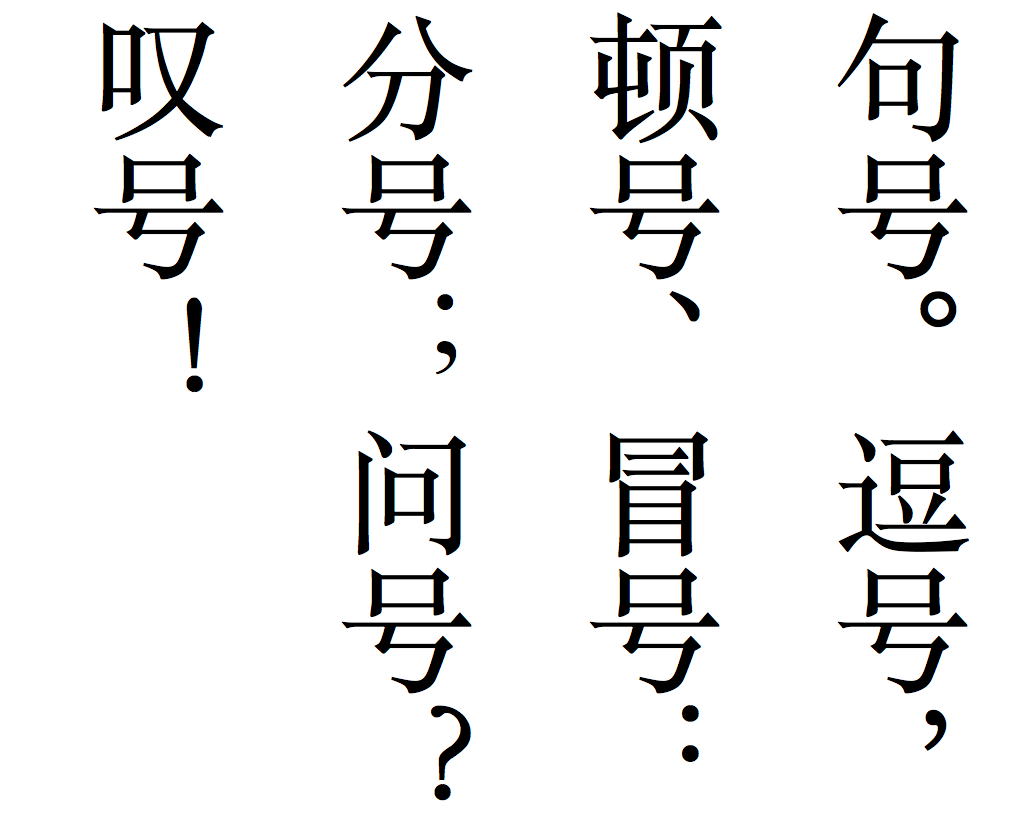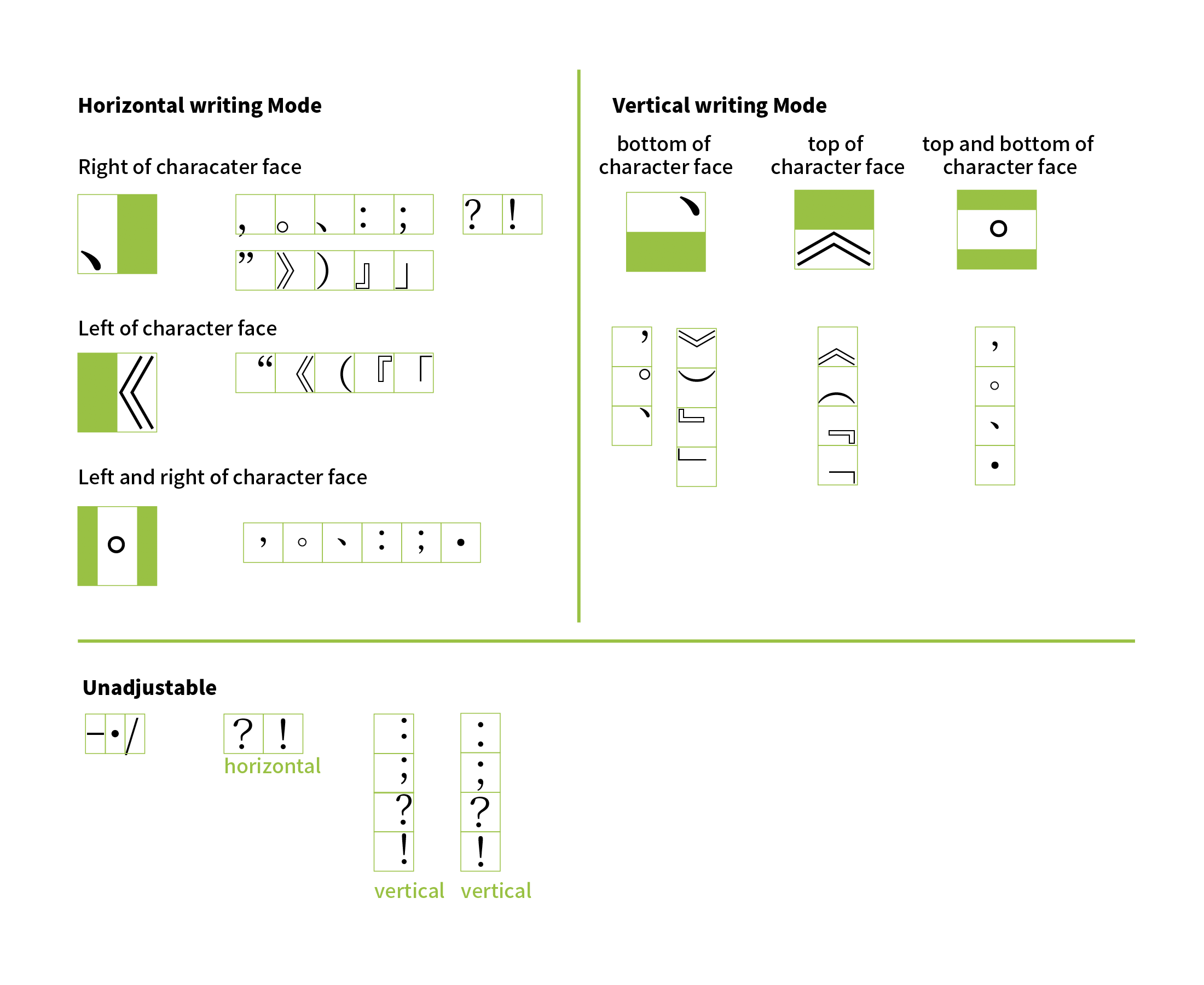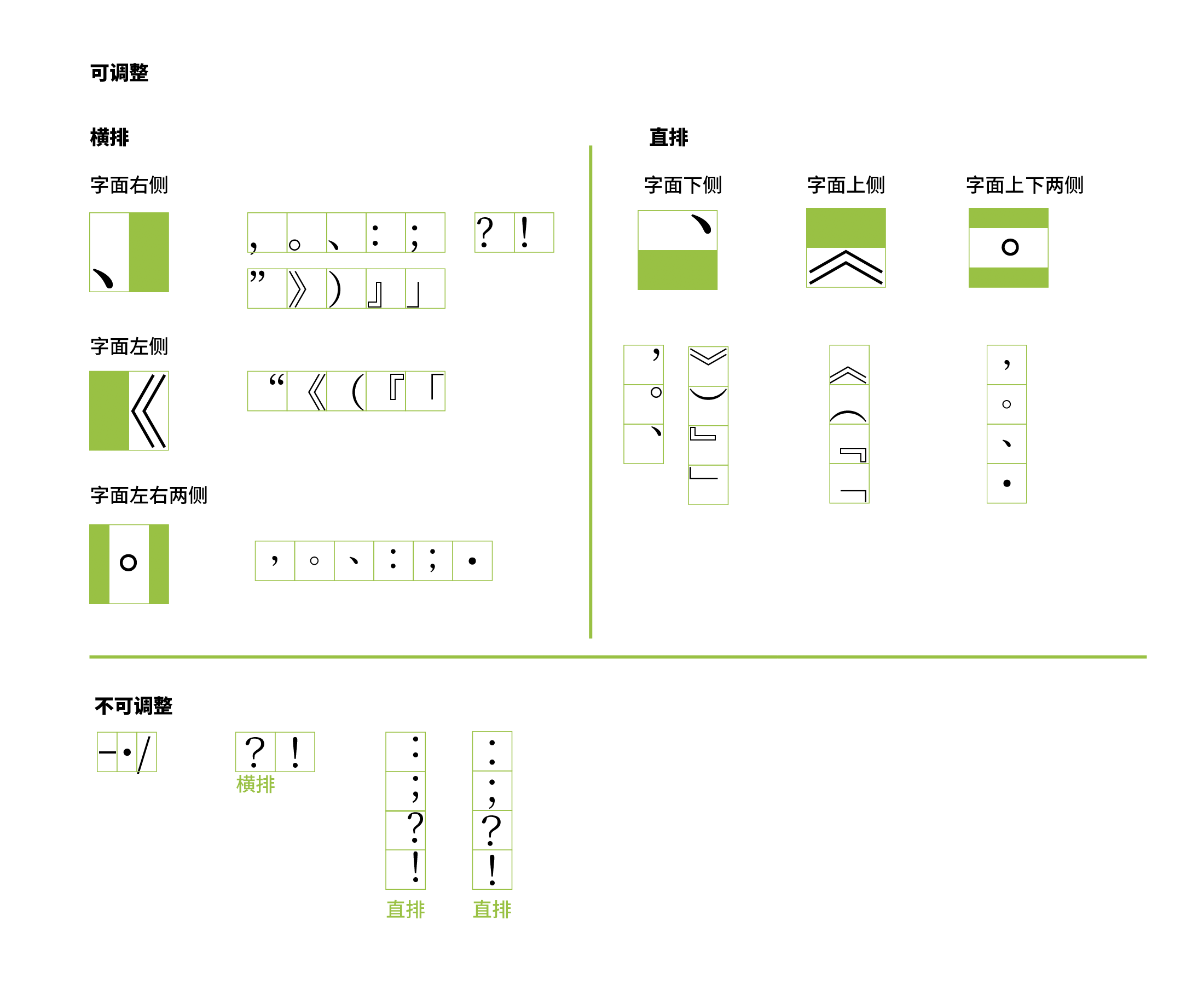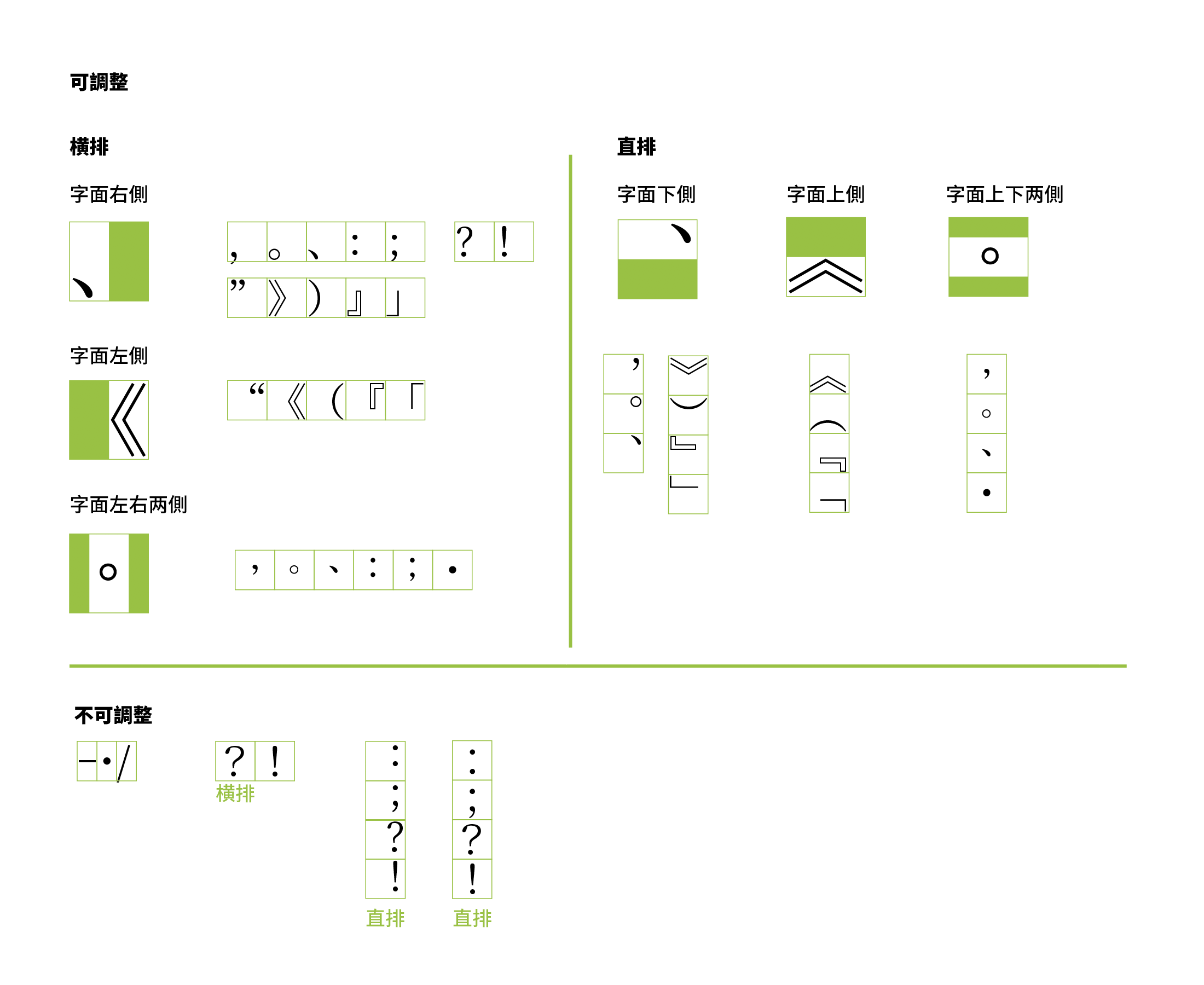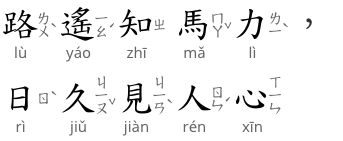| 阿拉伯數字 |
阿拉伯数字 |
Ālābó shùzì |
European numerals/Arabic numerals/Hindu–Arabic numerals/European digits (in Unicode) |
A general name of Hindu–Arabic numeral system. Hindu–Arabic numerals,
also called Arabic numerals or European digits (in Unicode) are the ten digits: 0, 1, 2, 3, 4, 5, 6, 7, 8, 9,
based on the Hindu–Arabic numeral system, the most common system for the symbolic representation of numbers in the world today.
[Definition from Wikipedia]
印度-阿拉伯数字的统称。阿拉伯数字是西方语言或欧洲形式的印度-阿拉伯数字,以十进制为基础,采用0、1、2、3、4、5、6、7、8、9共10个计数符号。采取位值法,高位在左,低位在右,从左往右书写。
印度-阿拉伯數字的統稱。阿拉伯數字是西方語言或歐洲形式的印度-阿拉伯數字,以十進位為基礎,採用0、1、2、3、4、5、6、7、8、9共10個計數符號。採取比特值法,高位在左,低位在右,從左往右書寫。
|
| 版心 |
版心 |
bǎnxīn |
type area |
The area, usually in the center of a printed page but without bleed and images,
works as the main area for content printing.
印刷成品版面中的图文印刷区域(不含出血图像)(GB 9851.2-2008, 3.3)。
印刷成品版面中的圖文印刷區域(不含出血圖像)(GB 9851.2-2008, 3.3)。
|
| 半形/半角 |
半形/半角 |
bànxíng/bànjiǎo |
halfwidth |
- A relative index for the length which is equal to 1/2 of a given character size.
- A square character frame that has a character advance of 1/2 character size.
排字的度量单位,宽度等于同样字号全角的一半。
排字的度量單位,寬度等於同樣字號全形的一半。
|
| 標點符號 |
标点符号 |
biāodiǎn fúhào |
punctuation marks |
The marks that aid texts to record language, and are an organic part of the written language. They are used to indicate pause, mood and special nature and functions of some parts (mainly words) in a sentence. (GB/T 15834—2011)
辅助文字记录语言的符号,是书面语的有机组成部分,用来表示语句的停顿、语气以及表示某成分(主要是词语)的特定性质和作用。(GB/T 15834—2011)
輔助文字記錄語言的符號,是書面語的有機組成部分,用來表示語句的停頓、語氣以及表示某成分(主要是詞語)的特定性質和作用。(GB/T 15834—2011)
|
| 標點符號擠壓 |
标点符号挤压 |
biāodiǎn fúhào jǐyā |
compression rules for consecutive punctuation marks |
The rules for type setting by compressing the space for
the punctuation marks in the beginning or ending of a line or the space between consecutive punctuation marks.
对位于行首、行尾或连续存在标点符号的富余空间进行调整的排版方式。
對位於行首、行尾或連續存在標點符號的富餘空間進行調整的排版方式。
|
| 標號 |
标号 |
biāohào |
indication punctuation marks |
Puctuation marks for indication, mainly for marking the special nature and function of a part (mainly words) of a sentence. (GB/T 15834—2011)
标号的作用是标明,主要标示某些成分(主要是词语)的特定性质和作用。(GB/T 15834—2011)
標號的作用是標明,主要標示某些成分(主要是詞語)的特定性質和作用。(GB/T 15834—2011)
|
| 標音 |
标音 |
biāoyīn |
phonetic annotation |
The way to indicate the pronunciation of the Han characters, e.g. interlinear annotations.
为汉字标注发音的方式,主要有行间注等。
為漢字標注發音的方式,主要有行間注等。
|
| 比例字體 |
比例字体 |
bǐlì zìtǐ |
proportional type |
A proportional typeface contains glyphs of varying widths in order to make the glyphs properly related in size. It is widely used in Western text.
西文字体的一种分类,此类字体中各字符的字幅大小不一。
西文字體的一種分類,此類字體中各字元的字幅大小不一。
|
| 出血 |
出血 |
chūxiě |
bleed |
The part of graphics that goes beyond the edge of final page that will be trimmed off.
超出成品幅面范围而被裁切掉的图像。(GB 9851.2-2008, 3.8)
超出成品幅面範圍而被裁切掉的圖像。(GB 9851.2-2008, 3.8)
|
| 大五碼 |
大五码 |
Dàwǔmǎ |
Big5 |
Big-5 or Big5 is a Chinese character encoding method used in Taiwan,
Hong Kong, and Macau for Traditional Chinese characters.
A total of 13060 Traditional Chinese characters are encoded with Big5.
[Definition from Wikipedia]
繁体中文常用的汉字编码字符集标准之一,共收录13,060个汉字。
繁體中文常用的漢字編碼字符集標準之一,共收錄13,060個漢字。
|
| 點 |
点 |
diǎn |
point (pt) |
In typography, the point is the smallest unit of measure, used for measuring font size, leading, and other items on a printed page.
The DTP point (desktop publishing point) as the de facto standard point is
defined as 1⁄72 of an international inch (about 0.35146 mm) and,
as with earlier American point sizes, is considered to be 1⁄12 of a pica.
[Definition from Wikipedia]
字号的一种计量单位,常用的英美点制下1点约为0.35146 mm,也被音译作“磅(因)”。
字號的一種計量單位,常用的英美點制下1點約為0.35146 mm,也被音譯作「磅(因)」。
|
| 點號 |
点号 |
diǎnhào |
pause or stop punctuation marks |
Punctuation marks for breaking, mainly for pause and mood, including marks at end-sentence and in-sentence.
点号的作用是点断,主要表示停顿和语气。分为句末点号和句内点号。(GB/T 15834—2011)
點號的作用是點斷,主要表示停頓和語氣。分為句末點號和句內點號。(GB/T 15834—2011)
|
| 頂端 |
顶端 |
dǐngduān |
line head |
The beginning side of the content in a type area.
Usually, for vertical writing, it is on the right side while for horizontal writing, it is at the top.
文本或文字靠近版面近起始的一端。通常,文字直排时顶端在右,横排在上。
文本或文字靠近版面近起始的一端。通常,文字直排時頂端在右,橫排在上。
|
| 段落 |
段落 |
duànlùo |
paragraph |
A paragraph is a self-contained unit of a discourse in writing dealing
with a particular point or idea. A paragraph consists of more than one sentence.
[Definition from Wikipedia]
由语句组成的句群,一个段落由一至多个语句组成。
由語句組成的句群,一個段落由一至多個語句組成。
|
| 對齊方式 |
对齐方式 |
duìqí fāngshì |
alignment |
In typesetting and page layout,
alignment or range is the setting of text flow or image placement relative to a page,
column (measure), table cell, or tab. The type alignment setting is sometimes referred to as text alignment,
text justification, or type justification.
[Definition from Wikipedia]
对字、行等各种元素的分布进行整理的方法。
對字、行等各種元素的分布進行整理的方法。
|
| 兒化音 |
儿化音 |
érhuàyīn |
rhotacization of syllable finals |
In standard Chinese and certain dialects, some words have rhotacized endings that result
in phonetic changes to how the word sounds.
在现代汉语以及一些方音里,一些词汇字音的韵母因卷舌动作而发生的音变现象。
在現代漢語以及一些方音裡,一些詞彙字音的韻母因捲舌動作而發生的音變現象。
|
| 繁體中文 |
繁体中文 |
fántǐ Zhōngwén |
Traditional Chinese |
The writing system of Chinese using characters that are relatively more complex in structure and stroke count. Known as Traditional Chinese because of its long history of use. Cf. Simplified Chinese.
字形及笔画相对较复杂的汉字体系。因使用时间较长,又名传统汉字或正体汉字,与之对应者为简体中文。
字形及筆畫相對較複雜的漢字體系。因使用時間較長,又名傳統漢字或正體漢字,與之對應者為簡體中文。
|
| 分詞連寫 |
分词连写 |
fēncí liánxiě |
words as the base units |
The usage of words as the segmentation unit for the romanisation of Chinese.
以汉语词为单位拼写罗马拼音的方式。
以漢語詞為單位拼寫羅馬拼音的方式。
|
| 分字連寫 |
分字连写 |
fēnzì liánxiě |
characters as the base units |
The usage of characters as the segmentation unit for the romanisation of Chinese.
以字为单位拼写罗马拼音的方式。
以字為單位拼寫羅馬拼音的方式。
|
| 符號分離禁則 |
符号分离禁则 |
fúhào fēnlí jìnzé |
prohibition rules for unbreakable punctuation |
The rules for certain punctuation marks that do not allow any spaces between them.
特定的符号里不得加入空隙的原则。
特定的符號里不得加入空隙的原則。
|
| 孤行 |
孤行 |
gūháng |
widow |
Literally "orphan line", the paragraph-ending line that falls at the beginning of a new page or column, or the paragraph-opening line that appears by itself at the end of a page or column; both separated from the rest of the text.
页面中首行为前页最后一个段落的末行者为孤行。
頁面中首行為前頁最後一個段落的末行者為孤行。
|
| 孤字 |
孤字 |
gūzì |
orphan |
Literally "orphan character", the paragraph-ending single character, with or without punctuation, became the last line of a paragraph.
段落末行仅有一个汉字,或一个汉字加上标点符号,该字即为孤字。
段落末行僅有一個漢字,或一個漢字加上標點符號,該字即為孤字。
|
| 行高 |
行高 |
hánggāo |
line height |
The height of a single line. Western text refer to this as the vertical distance between lines of text measured from base line to base line.
一行的高度,西文里通常指基线到基线的距离。
一行的高度,西文裡通常指基線到基線的距離。
|
| 行間注 |
行间注 |
hángjiānzhù |
interlinear annotations |
Annotations between lines used to indicate the pronounciation of a word or an explanation of a word.
标注于行间的说明或文字读音。
標注於行間的說明或文字讀音。
|
| 行內調整 |
行内调整 |
hángnèitiáozhěng |
line adjustment |
A method of aligning both edges of all lines (except the last line) in paragraph to be the same given length by removing or adding pre-defined adjustable spacing.
通过挤压或拉伸预先定义的可调整空间,将段落中每行(最后一行除外)首尾对齐的方法。
通過擠壓或拉伸預先定義的可調整空間,將段落中每行(最後一行除外)首尾對齊的方法。
|
| 行首行尾禁則 |
行首行尾禁则 |
hángshǒu hángwěi jìnzé |
prohibition rules for line start/end |
Due to the varied nature of the different punctuation marks, punctuation rules for the start of a line differ from that for the end of a line.
不同的标点依其性质,不得出现于行首或行尾的排版规则。
不同的標點依其性質,不得出現於行首或行尾的排版規則。
|
| 行尾點號懸掛 |
行尾点号悬挂 |
hángwěi diǎnhào xuánguà |
hanging punctuation marks for line end |
Typesetting punctuation for line endings outside the margin of alignment, also known as hanging punctuation or exdentation.
将行尾的点号悬挂于版心之外的排版方式。
將行尾的點號懸掛於版心之外的排版方式。
|
| 漢語拼音 |
汉语拼音 |
Hànyǔ pīnyīn |
Hanyu Pinyin |
Hanyu Pinyin provides a method of using Latin characters with diacritics to indicate tone. It is often used to teach Standard Chinese and encourage its use as a common language for communication.
《汉语拼音方案》给汉字注音和拼写普通话的一种方案,采用拉丁字母,并用附加符号表示声调,是帮助学习汉字和推广普通话的工具。
《漢語拼音方案》給漢字注音和拼寫普通話的一種方案,採用拉丁字母,並用附加符號表示聲調,是幫助學習漢字和推廣普通話的工具。
|
| 漢字 |
汉字 |
Hànzì |
Chinese characters/Han characters |
Characters that form the basis of the Chinese language.
中文的基本文字。
中文的基本文字。
|
| 橫排 |
横排 |
héngpái |
horizontal writing mode |
The process or the result of arranging characters on a line from left to right, of lines on a page from top to bottom, and/or of columns on a page from left to right.
行内每字按水平方向由左至右,页内每行从上至下、每栏由左至右的排列方法,或者按此方法的排列状态。
行內每字按水平方向由左至右,頁內每行從上至下、每欄由左至右的排列方法,或者按此方法的排列狀態。
|
| 活字排版 |
活字排版 |
huózì páibǎn |
letterpress printing |
The traditional printing method using movable type.
使用可以移动的字块进行文字排版及印刷的方式。
使用可以移動的字塊進行文字排版及印刷的方式。
|
| 簡體中文 |
简体中文 |
jiǎntǐ Zhōngwén |
Simplified Chinese |
The writing system of Chinese using characters that are relatively simpler in structure and stroke count, mainly refer to Jianhuazi (Simplified Character) published and revised in 1960s in Mainland China. Cf. Traditional Chinese.
字形及笔画相对较简单的汉字体系,主要指中国大陆于20世纪60年代左右公布修订的简化汉字,与之对应者为繁体中文。
字形及筆畫相對較簡單的漢字體系,主要指中國大陸於20世紀60年代左右公布修訂的簡化漢字,與之對應者為繁體中文。
|
| 夾注符號 |
夹注符号 |
jiázhù fúhào |
brackets |
General term for a pair of punctuation marks that isolate a segment of text from its surroundings and include additional information for clarification or for emphasis.
为提示或突显将文本夾注起来的一类成对符号的总称。
為提示或突顯將文本夾注起來的一類成對符號的總稱。
|
| 結束夾注符號 |
结束夹注符号 |
jiéshù jiázhù fúhào |
closing bracket(s) |
The ending character of the paired brackets, which includes quotation marks, parentheses, book title marks etc.
成对的夹注符号(引号、括号、书名号)中,标注结束的字符。
成對的夾注符號(引號、括號、書名號)中,標注結束的字元。
|
| 介音 |
介音 |
jièyīn |
medial |
The semivowel between initial and main vowel in Chinese syllable.
汉语音节的构成中,位于辅音和主要元音之间的过渡音。
漢語音節的構成中,位於輔音和主要元音之間的過渡音。
|
| 緊排 |
紧排 |
jǐnpái |
reduced inter-character spacing |
Adjustment of inter-character spacing by making the distance between the character face of adjacent characters shorter than that produced by solid setting.
减少字距,使文字外框一部分重叠的排版方式。
減少字距,使文字外框一部分重疊的排版方式。
|
| 基文 |
基文 |
jīwén |
base text |
Text to be annotated by ruby, ornament characters, or emphasis dots.
行间注排版中,受标注的原文字词或语句。
行間注排版中,受標注的原文字詞或語句。
|
| 開始夾注符號 |
开始夹注符号 |
kāishǐ jiázhù fúhào |
opening bracket(s) |
The opening character of the paired brackets, which includes quotation marks, parentheses, book title marks etc.
成对的夹注符号(引号、括号、书名号)中,标注起始的字符。
成對的夾注符號(引號、括號、書名號)中,標注起始的字元。
|
| 拉丁字母 |
拉丁字母 |
lādīng zìmǔ |
Latin letters |
The letters of Latin alphabet.
西文常用的字母。
西文常用的字母。
|
| 欄 |
栏 |
lán |
column |
A partition on a page in multi-column format.
将连续一系列的文章放在一页里,按照文字阅读方向分割成两个以上的每一个独立部分。
將連續一系列的文章放在一頁里,按照文字閱讀方向分割成兩個以上的每一個獨立部分。
|
| 欄間距 |
栏间距 |
lán jiānjù |
column gap |
Amount of space between columns on a page.
栏与栏之间的间距。
欄與欄之間的間距。
|
| 羅馬拼音 |
罗马拼音 |
luómǎ pīnyīn |
Romanization |
The conversion system of writing from Chinese pronunciation into Roman/Latin script.
将汉字依语言将其发音转写为拉丁字母的方式。
將漢字依語言將其發音轉寫為拉丁字母的方式。
|
| 密排 |
密排 |
mìpái |
solid setting |
To arrange characters with no inter-character space between adjacent character frames.
将文字依其外框紧密排列的排版方式。
將文字依其外框緊密排列的排版方式。
|
| 末端 |
末端 |
mòduān |
end point |
The ending point of a line, meaning the bottom side in vertical writing mode, or the right side in horizontal writing mode.
文本或文字靠近其所在行行尾的一端。通常,文字直排时末端在下,横排在右。
文本或文字靠近其所在行行尾的一端。通常,文字直排時末端在下,橫排在右。
|
| 排版樣式 |
排版样式 |
páibǎn yàngshì |
page format |
The layout and presentation of a page with text, graphics and other elements for a publication such as a book.
书籍等出版物上图、文及其他元素的版式布局及表现形式。
書籍等出版物上圖、文及其他元素的版式布局及表現形式。
|
| 輕聲 |
轻声 |
qīngshēng |
neutral tone |
A kind of special tone phenomenon in modern standard Chinese, with no fixed tone.
现代标准汉语的特殊变调现象,无固定调值。
現代標準漢語的特殊變調現象,無固定調值。
|
| 齊頭尾對齊 |
齐头尾对齐 |
qítóuwěi duìqí |
justified alignment |
The alignment method to align on both the left and right ends of each line of one paragraph text.
一种段落每行的行头行尾分别对齐的排版方式。
一種段落每行的行頭行尾分別對齊的排版方式。
|
| 全形/全角 |
全形/全角 |
quánxíng/quánjiǎo |
fullwidth |
- A relative index for the length which is equal to a given character size.
- A square character frame that has a character advance of character size.
排字的一种相对度量单位,宽度等于所使用的字号,用做排版宽度水平方向的度量。
排字的一種相對度量單位,寬度等於所使用的字號,用做排版寬度水平方向的度量。
|
| 入聲 |
入声 |
rùshēng |
checked tone |
One of four tones in Historical Chinese phonology, which has short and brief pitch.
汉语及汉语方言的音节结构,属四声之一,其调值之调型短而急促。
漢語及漢語方言的音節結構,屬四聲之一,其調值之調型短而急促。
|
| 聲調 |
声调 |
shēngdiào |
tone |
The pitch contours in language to distinguish lexical or grammatical meaning in one syllable. There are 4 tones, e.g. Ping (level), Shang (rising), Qu (departing), Ru (entering) in Historical Chinese phonology.
音节的高低升降变化。汉语传统音韵学里分为平、上、去、入等四声。
音節的高低升降變化。漢語傳統音韻學裡分為平、上、去、入等四聲。
|
| 聲母 |
声母 |
shēngmǔ |
initial |
The initial consonant of a Chinese syllable.
汉语字音音节开头的辅音。
漢語字音音節開頭的輔音。
|
| 始端 |
始端 |
shǐduān |
starting point |
The text or character that is near the beginning of the line. Normally, when the text is in vertical writing mode, the starting point is on the top; in horizontal writing mode, the starting point is on the left.
文本或文字靠近该行行首的一端。通常,文字直排时始端在上,横排在左。
文本或文字靠近該行行首的一端。通常,文字直排時始端在上,橫排在左。
|
| 疏排 |
疏排 |
shūpái |
Loose setting |
Text setting with extra even inter-character spacing in addition to the default spacing between characters, achieved by applying positive tracking to the text.
于各字之间加入均匀空白的排版方式。
於各字之間加入均勻空白的排版方式。
|
| 天/天頭 |
天/天头 |
tiān/tiāntóu |
head/top margin |
The top margin between the top edge of a trimmed page and the type area.
版心上沿至成品幅面上沿之间的空白区域 (GB/T 9851.2-2008, 3.4)
版心上沿至成品幅面上沿之間的空白區域 (GB/T 9851.2-2008, 3.4)
|
| 文字設計/字體排印 |
文字设计/字体排印 |
wénzìshèjì/zìtǐpáiyìn |
typography |
The art and technique of arranging type to make written language legible, readable, and appealing when displayed. [Definition from Wikipedia]
对文字进行合适地排版让书面语言易认、易读、有吸引力地展现出来的一种工艺。
對文字進行合適地排版讓書面語言易認、易讀、有吸引力地展現出來的一種工藝。
|
| 文字外框 |
文字外框 |
wénzìwàikuāng |
character frame |
Rectangular area occupied by a character when it is set solid.
文字密排时所占矩形区域。
文字密排時所占矩形區域。
|
| 西文 |
西文 |
Xīwén |
Western text |
Writing systems derived from Greek and Latin.
欧洲、美洲和大洋洲通行的文字。
歐洲、美洲和大洋洲通行的文字。
|
| 以連字符斷行 |
以连字符断行 |
yǐ liánzìfú duànháng |
hyphenation |
Use of the hyphen to join words and to separate syllables of a single word.
在西文词组音节间插入连字符来断行的方式。
在西文詞組音節間插入連字符來斷行的方式。
|
| 韻母 |
韵母 |
yùnmŭ |
final |
The part in a Chinese syllable without initial and tone.
汉语字音中一个音节中除声母、声调外的部分。
漢語字音中一個音節中除聲母、聲調外的部分。
|
| 製表定位字元 |
制表定位字元 |
zhìbiǎodìngwèizìyuán |
tab |
Characters with the feature of tabulation.
提供按列对齐文本功能的字元。
提供按列對齊文本功能的字元。
|
| 直排/豎排 |
直排/竖排 |
zhípái (shùpái) |
vertical writing mode |
The process or the result of arranging characters on a line from top to bottom, of lines on a page from right to left, and/or of columns on a page from top to bottom.
行内每字按垂直方向由上至下,页内每行从右至左、每栏由上至下的排列方法,或者按此方法的排列状态。
行內每字按垂直方向由上至下,頁內每行從右至左、每欄由上至下的排列方法,或者按此方法的排列狀態。
|
| 中外文對照 |
中外文对照 |
Zhōng-wàiwén duìzhào |
bilingual annotations |
To prompt a Chinese term with its original or translation in the form of annotation text or base text, an instance of interlinear annotation.
以注文或基文的形式为汉语词组提示原文或译文,系行间注排版的一种实现方式。
以注文或基文的形式為漢語詞組提示原文或譯文,係行間注排版的一種實作方式。
|
| 中、西文混排處理 |
中、西文混排处理 |
Zhōng-Xīwén hùnpái chǔlǐ |
Chinese and Western mixed text composition |
The process of interleaving Chinese text with Western text.
在中文文本中,包含部分西文時的處理方式。
在中文文本中,包含部分西文時的處理方式。
|
| 注文 |
注文 |
zhùwén |
annotation text |
Interlinear text run indicating pronunciation or definitions.
行间注排版中,标注于行间(原文字词或语句旁侧)以标注发音或释义的文字。
行間注排版中,標注於行間(原文字詞或語句旁側)以標注發音或釋義的文字。
|
| 注音符號 |
注音符号 |
zhùyīn fúhào |
Bopomofo (Zhuyin) |
The general name of Mandarin Phonetic Symbols and Taiwanese Phonetic Symbols.
“国语注音符号”及“台湾方音符号”的统称。
「國語注音符號」及「台灣方音符號」的統稱。
|
| 字幅 |
字幅 |
zìfú |
character advance |
Size of a character frame in the inline direction.
字符在行方向上的大小。
字符在行方向上的大小。
|
| 字號 |
字号 |
zìhào |
type size |
Dimensions of a character.
区别单个字符大小的表示方法。(GB 9851.2-2008, 3.3)
區別單個字符大小的表示方法。(GB 9851.2-2008, 3.3)
|
| 字距 |
字距 |
zìjù |
tracking |
The space between characters.
字符之间的空隙。
字符之間的空隙。
|
| 字面 |
字面 |
zìmiàn |
character face |
Area in which glyph is drawn.
文字的字身框中,字图实际分布的空间。
文字的字身框中,字圖實際分布的空間。
|
| 字體 |
字体 |
zìtǐ |
typeface |
A set of letters, characters or symbols, which are designed to have coherent patterns to be used for printing or rendering to a computer screen.
字母、文字或符号的一组集合,一个字体通常有一贯的笔画与字形风格,用于印刷或屏幕渲染中。
字母、文字或符號的一組集合,一個字體通常有一貫的筆畫與字形風格,用於印刷或螢幕渲染中。
|
| 字型 |
字型 |
zìxíng |
font |
A set of glyphs with the same design, often referred to as typeface nowadays.
具有相同基本设计的字形图像集合(GB/T 16964.1-1997, 3.6),现多与字体混用。
具有相同基本設計的字形圖像集合(GB/T 16964.1-1997, 3.6),現多與字體混用。
|
| 字形 |
字形 |
zìxíng |
glyph |
A symbol of identifiable abstraction, depending on no specific design.
字母、文字或符号在书写、印刷上的形体。
字母、文字或符號在書寫、印刷上的形體。
|
| 縱橫對齊 |
纵横对齐 |
zònghéng duìqí |
grid alignment |
The process, under the premise of justification, of arranging characters within grids to make sure that they are aligned in both horizontal and vertical axes.
头尾对齐的前提下,保证各行文字在横、纵轴二方向皆相互对齐排列于网格中的排版方式。
頭尾對齊的前提下,保證各行文字在橫、縱軸二方向皆相互對齊排列於網格中的排版方式。
|
| 縱中橫排 |
纵中横排 |
zòngzhōnghéngpái |
horizontal-in-vertical setting |
To typeset a (small) group of characters horizontally within a vertical line of main text.
在直排文本中,将成(小)组的字符横排插入排版方式。
在直排文本中,將成(小)組的字符橫排插入排版方式。
|
